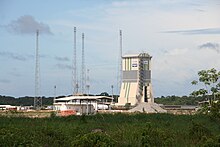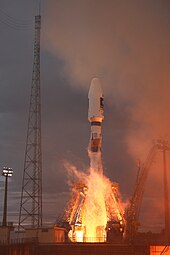ELS (launch pad)
ELS ( E nsemble de L ancement S oyouz ) is a launch pad of the Guiana Space Center (CSG) at Kourou in French Guiana , from where missiles of Russian type Soyuz can be started. The first launch of the ELS took place on October 21, 2011 with a Soyuz ST , also called Soyuz STK , and two European Galileo navigation satellites as payloads.
Location
The launch site is located in the north-western part of the CSG. The distance from the city of Kourou is 27 km, 10 km from the active Ariane launcher ELA-3 and 18 km from the municipality of Sinnamary , on whose premises the ELS is located. It is located north of the RN1 road, so you can take off unhindered to the north over the sea. The ELS site is 1.2 km² in size, of which 20,000 m² are built over. When the foundation stone was laid in 2007, a 20 kg stone from the Soyuz launch pad in Baikonur was installed in the launch pad , from which Yuri Gagarin took off on the first manned space flight in 1961.
construction
The site is divided into two areas: the preparation area (Zone de Preparation, ZP) and the start area (Zone de Lancement, ZL).
The control desk (Center de Lancement, CDL) is located on the edge of the preparation area. Its roof consists of a 2 m thick layer of concrete. The integration building MIK (Montazhno-Ispitatielniï Korpoussagrandi) is located in the middle of the preparation area, about 625 m from the launch site. It is 92 m long, 41 m wide and 22 m high. In it the Soyuz rocket, the Fregat upper stage and the boosters of the first stage are prepared. As is customary in Russia and Kazakhstan, the rocket is stored horizontally and is then transported to the launch pad on rails.
When it arrives at the launch site, the rocket is brought into a vertical position and suspended in four radial steel arms (called the tulip ) that can be pivoted upwards , which carry the rocket and release it after the engine has been fired. At the Soyuz launch system in Baikonur, the undercarriage of these arms can be rotated to allow different firing directions, which was necessary for the older Soyuz versions with analog flight controls, which could not adjust the azimuth of the orbit. In the CSG, only Soyuz versions with digital flight control with active azimuth adjustment are used, so that the underframe with a diameter of 16 m and a weight of 300 t could be permanently installed.
The mobile assembly tower MBO (Mobilnaïa Bachnia Obslouzhivania) holds the missile before launch. It is 53 m high, 29 m deep, 24 m wide and has a mass of 800 t. It enables access to the rocket on 11 floors. The payload is assembled from here. Deviating from the procedure practiced on the Russian and Kazakh launch sites of fully assembling the rocket including the payload in a horizontal position, the Fregat upper stage together with the payload with its fairing on the ELS is only opened after the carrier has been erected in stages 1 to 3 placed on the start table in a vertical position.
There are also four large masts on the launch site that serve as lightning rods and storage tanks for the liquid fuels.
Web links
- Soyuz and Soyuz Launch Complex on the CSG website
- L'Ensemble de Lancement Soyouz (ELS) au CSG (French)
Individual evidence
- ^ Soyuz in Kourou. German Aerospace Center , accessed on April 6, 2019 .
- ^ Soyuz rockets on the way to Kourou ( Memento from December 22, 2015 in the Internet Archive ), article in the Frankfurter Rundschau of November 7, 2009, accessed on October 19, 2011
- ↑ Installation of the Soyuz launch system begins at Europe's Spaceport ( English ) April 19, 2009. Archived from the original on March 30, 2009. Retrieved on April 6, 2014.
Coordinates: 5 ° 18 ′ 7 " N , 52 ° 50 ′ 4" W.


